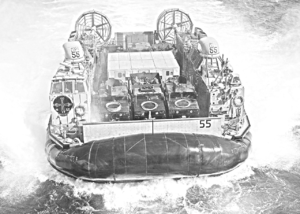Strider-class landing craft
 Strider-class landing craft | |
| Type | Landing craft air cushion |
|---|---|
| Place of origin |
|
| In commission | 1680 AN |
| Number built | TBD |
| Designed | 1677–1679 AN |
| Manufacturer | Port Niyi Shipyards (Sanama) |
| Crew | 5 |
| Mass | 185 t full load |
| Length | 26.4 m |
| Width | 14.3 m |
| Propulsion | 4x PNS gas turbines |
| Speed | 40+ knots (74 km/h) with full load, 70+ knots (130 km/h) maximum speed |
| Range | 370 km at 75 km/h with payload, 550 km at 65 km/h with payload |
| Payload capacity | 54 tons, up to 68 tons overloaded. |
| Military lift | 180 troops or 1 MBT. |
| Armament | 2x 12.7 mm machine guns. Mounts support .50 cal machine gun, 40 mm grenade launcher, 7.62 mm machine gun, 30 mm Gatling gun. |
The Strider-class landing craft is a class of amphibious landing crafts designed and built in Sanama by Port Niyi Shipyards. It is designed to be carried by the PNS-designed and built amphibious assault ships, but can also operate independently. In addition to beach landing, the class provides personnel transport, evacuation support, lane breaching, mine countermeasure operations, and Marine and Special Warfare equipment delivery. The four main engines are all used for lift and all used for main propulsion. The craft can continue to operate, at reduced capability, with two engines inoperable. They are interchangeable for redundancy. A transport model can seat 180 fully equipped troops. The class is a dramatic innovation in modern amphibious warfare technology. It provides the capability to launch amphibious assaults from points over the horizon (OTH) from up to 93 km offshore, thereby decreasing risk to ships and personnel and generating greater uncertainty in the enemy's mind as to the location and timing of an assault, thereby maximizing its prospects of success. The hovercraft's propulsion system makes it less susceptible to mines than other assault craft or vehicles. Due to its tremendous over-the-beach capability, the class can access more than 80% of the world's coastlines. Previously, landing craft had a top speed of approximately 15 km/h and could cross only 17% of the world's beach area. Assaults were made from a few miles off-shore. Its high speed complements a joint assault with helicopters, so personnel and equipment can be unloaded beyond the beach in secure landing areas.